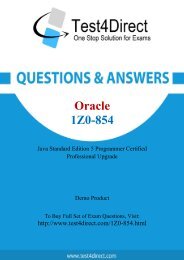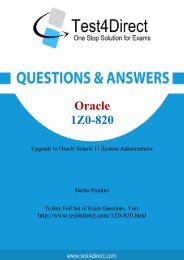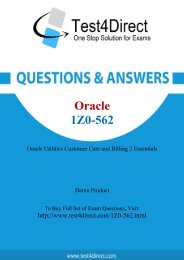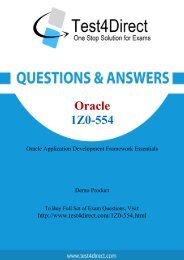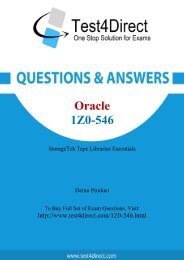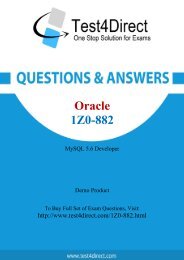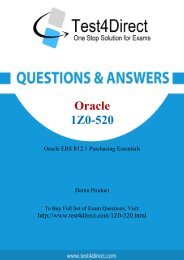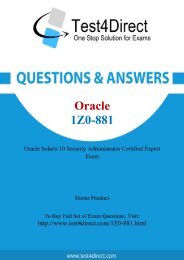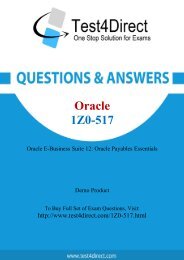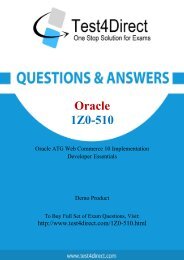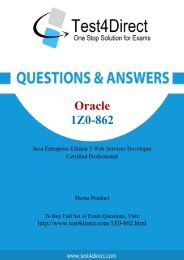1Z0-543 Exam BrainDumps
Test4Direct provides latest PDF questions of Oracle 1Z0-543 exam. You have an opportunity to pass the Oracle 1Z0-543 exam in one go. Test4Direct is most accurate source to prepare Oracle 1Z0-543 exam as your success will become site’s responsibility after purchasing 1Z0-543 exam product. There are also lots of discounts and promotion offers that you can avail. Let’s try a free demo http://www.test4direct.com/1Z0-543.html
Test4Direct provides latest PDF questions of Oracle 1Z0-543 exam. You have an opportunity to pass the Oracle 1Z0-543 exam in one go. Test4Direct is most accurate source to prepare Oracle 1Z0-543 exam as your success will become site’s responsibility after purchasing 1Z0-543 exam product. There are also lots of discounts and promotion offers that you can avail. Let’s try a free demo http://www.test4direct.com/1Z0-543.html
Create successful ePaper yourself
Turn your PDF publications into a flip-book with our unique Google optimized e-Paper software.
Oracle<br />
<strong>1Z0</strong>-<strong>543</strong><br />
Oracle Application Integration Architecture 11g Essentials<br />
Demo Product<br />
To Buy Full Set of <strong>Exam</strong> Questions, Visit:<br />
http://www.test4direct.com/<strong>1Z0</strong>-<strong>543</strong>.html
Question: 1<br />
What is the purpose of harvesting?<br />
A. to parse the implementation artifacts and persist their metadata to the AIA backend<br />
B. to source control the implementation artifacts<br />
C. to test the implementation<br />
D. to collect the produced artifacts and store them<br />
Question: 2<br />
Question: 3<br />
Answer: A<br />
Explanation:<br />
Harvesting of Artifacts. The metadata can be submitted to Oracle Enterprise Repository either from<br />
the command line, from Oracle JDeveloper, or using an Ant task.<br />
The Harvester scans for artifacts and harvests those artifacts to detect the dependencies that exist<br />
between them. The Harvester creates entities for these artifacts in Oracle Enterprise Repository and<br />
creates the relationships between them.<br />
Reference: Oracle Fusion Middleware Configuration Guide for Oracle Enterprise Repository,<br />
Harvesting of Artifacts<br />
Which statement is true about the AIAConfigurationProperties.xml file?<br />
A. All the service-level configuration properties are stored within the module-level properties.<br />
B. All the module-level configuration properties are stored within the service-level properties.<br />
C. All the module-level configuration properties are stored within the system-level properties.<br />
D. All the service-level configuration properties are stored within the system-level properties<br />
Answer: C<br />
Explanation:<br />
AIA provides external configuration properties to influence the run-time behavior of system,<br />
infrastructure components, and services. These properties are provided as name-value pairs at the<br />
system, module, and service levels in AIAConfigurationProperties.xml.<br />
The AIAConfigurationProperties.xml supports two types of configurations:<br />
* System level, including module level<br />
Contains system-level configuration name-value pairs and module-level configuration name-value<br />
pairs within the system level.<br />
* Service level<br />
Contains service-specific configuration name-value pairs.<br />
Note: The AIA framework has this configuration file, AIAConfigurationProperties.xml, which groups a<br />
lot of information about the environment - logging levels, notification recipients, and a great deal of<br />
error handling behaviour.
How do you jump start standards-compliant service deployment?<br />
A. By using AIA code generator tool to create a skeleton of ABCS<br />
B. By creating ABCS manually and by executing PIP Auditor to check compliance<br />
C. By enforcing sticker qa checks<br />
D. By manual code walkthrough<br />
Question: 4<br />
Question: 5<br />
Answer: A<br />
Explanation:<br />
AIA Service Constructor is an application that helps jump-start ABCS development by pregenerating<br />
AIA artifacts complying with architectural recommendations. It generates artifacts according to the<br />
AIA architecture naming recommendations and relieves developers of performing repeatable<br />
mundane tasks, making them focus more on value-added business scenario-specific tasks.<br />
Reference: Oracle Fusion Middleware Concepts and Technologies Guide for Oracle Application<br />
Integration Architecture Foundation Pack, Constructing an ABCS Using Service Constructor<br />
For upgrades, knowing what custom mappings have been done can be very useful for customers to<br />
identify whether the upgrade will cause any functional issues. How will you identify the functional<br />
issues?<br />
A. XMAN (mapping compliance reports) reports in the CSV can be analyzed to find duplicate EBM<br />
mappings that also contain extended records.<br />
B. XMAN (mapping compliance reports) CSV reports can be analyzed to find the ABCS name that has<br />
changed.<br />
C. PIP Auditor reports can be analyzed to figure out the compliance of upgraded PIP.<br />
D. EOL2CSV reports can be analyzed to find the correct ABCS for specific business flow.<br />
Answer: B<br />
Explanation:<br />
The reuse of artifacts and effective information sharing are key principles of SOA governance. The<br />
XSL Mapping Analyzer (XMAN) analyzes mapping information that exists in cryptic Application<br />
Business Connector Service (ABCS) XSLT files and provides it in a more readable format so that<br />
existing connector mappings can be easily considered for reuse.<br />
Being able to comprehend the mappings between an Application Business Message (ABM) and an<br />
Enterprise Business Message (EBM) becomes imperative when developing a connector based on<br />
existing connectors.<br />
When preparing for an upgrade, use XMAN to compare customized mappings to Oracle-supplied<br />
mappings. Evaluate the results of these comparisons and make any necessary changes before<br />
performing the upgrade.<br />
Incorrect answers:<br />
C: PIP Auditor - Used to check if given BPEL and ESB projects follow the AIA methodology for coding<br />
conventions.Reference: Oracle Application Integration Architecture, Infrastructure Components and<br />
Utilities Guide
Which two statements are true for a requester ABCS?<br />
A. It receives the ABM as pay load and optionally returns the ABM as the response.<br />
B. It cannot have additional interactions with the requester application to enrich the ABM.<br />
C. It is supplied by the provider application to interface with an EBS.<br />
D. It enables the participating application to invoke an EBS either to access data or to perform<br />
transactional task.<br />
Question: 6<br />
Question: 7<br />
Answer: A, D<br />
Explanation:<br />
An ABCS (Application Business Connector Services) can be requester-specific or providerspecific.<br />
A requester ABCS accepts the request from the client application through a client-specific<br />
Application Business Message (ABM) and returns the response to the client application through a<br />
client-specific ABM. The role of the requester ABCS is to act as a vehicle to enable the participating<br />
application to invoke the EBS either to access data or to perform a transactional task. (D) The client<br />
side ABM is the payload that is passed by the requester application to the requester ABCS.<br />
The requester application that wants to leverage an action must define the requester-specific ABCS.<br />
The requester application that wants to implement this ABCS could be Siebel CRM, PeopleSoft<br />
Enterprise CRM, or Oracle eBusiness Suite CRM. The requester application-specific ABCS must take<br />
the requester application-specific ABM as input and provide the requester application-specific ABM<br />
as output.<br />
Reference: Oracle Fusion Middleware Concepts and Technologies Guide for Oracle Application<br />
Integration Architecture Foundation Pack, Introduction to ABCS<br />
Which two statements are true about Enterprise Business Flow (EBF) in context of Oracle AIA?<br />
A. The EBF will have no activity that needs human-to-human interaction.<br />
B. The EBF will involve only human-to-human or service-to-service Interaction.<br />
C. The EBF will involve only system-to-system or service-to-service Interaction.<br />
D. The EBF will involve only system-to-system or human-to-human interaction.<br />
Answer: A, C<br />
Explanation:<br />
The EBF involves only system-to-system or service-to-service interaction. The EBF has no activity that<br />
needs human intervention.<br />
Note: The EBF is used for implementing a business activity or a task that involves leveraging<br />
capabilities available in multiple applications. The EBF is about stringing together a set of capabilities<br />
available in applications to implement a coarse-grained business activity or task and composing a<br />
new service leveraging existing capabilities.<br />
Reference: Oracle Fusion Middleware Concepts and Technologies Guide for Oracle Application<br />
Integration Architecture Foundation Pack, Introduction to Enterprise Business Flows<br />
Which one best defines where an EBO is defined?
A. WSDL document<br />
B. XSD document<br />
C. Java source file<br />
D. .cfg configuration file<br />
Answer: B<br />
Explanation:<br />
EBOs (Enterprise Business Objects) have the following characteristics:<br />
* They contain components that satisfy the requirements of business objects from the source and<br />
target application data models.<br />
* EBOs differ from other data models in that they are not data repositories.<br />
Instead, they provide the structure for exchanging data. XML provides the vocabulary for expressing<br />
business data. The XML schema is an XSD file that contains the application-independent data<br />
structure to describe the common object.<br />
* Each EBO is represented in an XML schema (XSD) file format.<br />
Reference: Oracle Fusion Middleware Concepts and Technologies Guide for Oracle Application<br />
Integration Architecture Foundation Pack, Introduction to EBOs
THANKS FOR TRYING THE DEMO OF OUR PRODUCT<br />
Visit Our Site to Purchase the Full Set of Actual <strong>1Z0</strong>-<strong>543</strong> <strong>Exam</strong> Questions With Answers.<br />
http://www.test4direct.com/<strong>1Z0</strong>-<strong>543</strong>.html<br />
We Also Provide Practice <strong>Exam</strong> Software That Simulates Real <strong>Exam</strong> Environment And Has<br />
Many Self-Assessment Features. Download Free Product Demo From:<br />
http://www.test4direct.com/<strong>1Z0</strong>-<strong>543</strong>.html<br />
Money Back Guarantee<br />
Check Out Our Customer Testimonials






